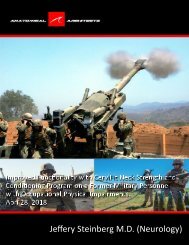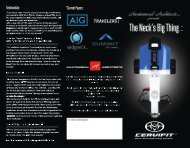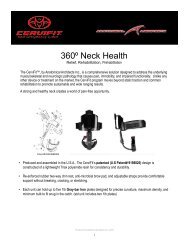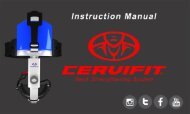CerviFit 2018
Having the distinction as the only intuitive Cervical rehabilitation/traction device that utilizes isotonic resistance and allows the user to condition the muscles of the neck, express the lymphnodes, improve range of motion and reduce pain associated with cervicalgia.
Having the distinction as the only intuitive Cervical rehabilitation/traction device that utilizes isotonic resistance and allows the user to condition the muscles of the neck, express the lymphnodes, improve range of motion and reduce pain associated with cervicalgia.
You also want an ePaper? Increase the reach of your titles
YUMPU automatically turns print PDFs into web optimized ePapers that Google loves.
360⁰ Neck Health<br />
Relief, Rehabilitation, Prehabilitation<br />
The <strong>CerviFit</strong>, by Anatomical Architects Inc., is a comprehensive system designed to address<br />
musculoskeletal and neurologic impairment of the cervical spine to relieve pain, relax muscle spasms, and<br />
recondition critical musculature in a gentle and controllable manner that supports the natural curvature of the<br />
spine.<br />
Intended for at-home and clinical use, our mission is to promote sustainable neck health by addressing the<br />
full spectrum of: Relief, Rehabilitation, & Prehabilitation.<br />
• Produced and assembled in the U.S.A., The <strong>CerviFit</strong>’s patented mainframe is constructed of lightweight<br />
Triax polyamide resin for consistency and durability.<br />
• Re-enforced rubber two-way chin rest, anti-microbial brow pad, and adjustable straps provide comfortable<br />
support without breaking, cracking, or stretching.<br />
• Each unit can hold up to 5 1lb Graybar Iron plates designed for precise curvature, maximum density, and<br />
minimum bulk to fit snug in the catch. (std unit includes 2*1lb plates)<br />
Product of Anatomical Architects Inc. 2017
Home Use Traction Solution Comparison<br />
• The <strong>CerviFit</strong> distinguishes itself from traditional over the door or pneumatic traction by providing a<br />
comfortable, consistent decompression of the cervical vertebrae while gently stretching the muscles of the<br />
neck and respecting the natural spinal curvature.<br />
• <strong>CerviFit</strong> can address multiple planes and directions including rotation for range of motion as opposed to<br />
traditional UP\DOWN FWD\BACK restrictions. Long term improvement to general cervical health promoted<br />
by <strong>CerviFit</strong> reduces pain beyond short term relief.<br />
• Truly portable with no physical tether, battery, or electrical constraint. The <strong>CerviFit</strong> has no messy water bags,<br />
no risk of mechanical failure, no inconsistent weight distribution, no worry of improper sizing. Ease of use<br />
and durability improve patient compliance for treatment as prescribed.<br />
<strong>CerviFit</strong><br />
Inflatable\Mechanical<br />
Traction<br />
Over Door Traction<br />
Short Term Relief<br />
Rotational Planes of Address<br />
Portability<br />
Storage\Cleaning<br />
Long Term Improvement\Decrease<br />
Recurrence<br />
Durability\No Mechanical Failure<br />
Size and Fit\Adjustability<br />
Weight Control and Consistency<br />
Ease of Use<br />
Rehabilitative Properties<br />
Product of Anatomical Architects Inc. 2017
Intended for at-home and clinical use, the <strong>CerviFit</strong> promotes sustainable neck health by addressing the full<br />
spectrum of: Relief, Rehabilitation, Prehabilitation according to unique, targeted protocols prescribed by a<br />
medical professional according to individual indications and limitations.<br />
Traction for Relief – The <strong>CerviFit</strong> Utilizes isotonic resistance and a<br />
patented fulcrum design allowing low weight and controlled movement<br />
to gently stretch the desired area without drooping, unnatural pulling or<br />
jerking. Cervifit can be prescribed for static or intermittent traction relief<br />
according to medical recommendation and individual limitations.<br />
Common Therapeutic Benefits of Cervical Traction<br />
Cervical traction with The <strong>CerviFit</strong> gently stretches and<br />
releases muscles, reduces muscle spasm, and improves range<br />
of motion\flexibility. Blood vessels compressed by muscle rigidity<br />
are allowed to relax, enabling blood flow and lymphatic circulation<br />
to return to the affected area.<br />
Common Conditions\Symptoms Treated by Traction include:<br />
• Pain\Stiffness When Moving Neck – relieve neck pain by<br />
stretching muscles and ligaments to release tension and<br />
reduce spasm. Flexibility and range of motion improvement,<br />
teamed with decompression of spinal structures can alleviate<br />
pain caused by compressed neural structures.<br />
• Tension Headaches – for headache pain, cervical traction<br />
has been found especially effective. Research suggests that<br />
one-fifth of chronic unilateral headache pain is cervical in<br />
origin.<br />
• Myofascial Pain – (MPS) of the shoulder and neck is often<br />
associated with injury, degenerated posture, and ergonomic<br />
stressors that develop after prolonged computer use.<br />
Traction, combined with targeted exercise have shown<br />
clinical success as effective treatment.<br />
• Numbness and Tingling in Hands\Arms - Numbness in the<br />
upper extremities may result from nerve impingement or<br />
entrapment resulting from common disc issues. Even<br />
distraction by small-increment isotonic resistance opens<br />
anterior and posterior disc space, relieving pressure on<br />
nerves and blood vessels.<br />
• Whiplash – effectively treat whiplash injuries and whiplash<br />
associated chronic headache. Relieve the muscle spasms<br />
associated with whiplash pain, improve blood flow to the<br />
injured muscles and relieve potentially whiplash-related TMJ<br />
symptoms.<br />
• Thoracic Outlet Syndrome (TOS) – TOS is neck, shoulder<br />
or arm pain that may be neurogenic in origin, resulting from<br />
compression of the brachial plexus; vascular, resulting from<br />
compression of the subclavian artery or vein; or nonspecific<br />
(i.e., unknown etiology). TOS frequently occurs as a result of<br />
ergonomic stressors. Cervical traction decompresses<br />
structures pinching the nerves and vasculature to alleviate<br />
symptoms.<br />
• TMJ Dysfunction - Targeted cervical traction has proven<br />
effective for relieving TMJ pain12 and helps increase patient<br />
awareness of muscle tension that contributes to TMJ. TMJ<br />
frequently presents with neck and facial pain and cervical<br />
traction may act to alleviate symptoms of these co-occurring<br />
and inter-related disorders.<br />
• Repetitive Strain Injury (RSI) – Primarily from occupational<br />
or recreational activities causing pain, weakness, and<br />
paresthesia, the resulting poor posture from weakened<br />
muscles and muscle memory can be difficult to change as<br />
strong muscles are more easily retrained. Cervical traction<br />
can be used to alleviate immediate symptoms and prepare<br />
the region through improved musculoskeletal alignment for<br />
targeted muscle conditioning.<br />
Product of Anatomical Architects Inc. 2017
The <strong>CerviFit</strong> moves beyond traditional relief and rehabilitation by extending treatment capability to multiple,<br />
natural, directional planes previously unaddressed. Just as each patient’s symptoms and limitations are<br />
unique, <strong>CerviFit</strong>’s rehabilitative protocols are tailored by medical professionals to produce patient-specific<br />
results and avoid exacerbation.<br />
Rotational Stretch and Strengthen – The <strong>CerviFit</strong>, movements gently<br />
stretch along the rotational planes respecting the natural and unique<br />
musculature and curvature of the spine.<br />
Cervifit can be prescribed for targeted stretching and extension of the<br />
sternocleidomastoid and trapezoids muscle groups, as well as medial<br />
and lateral rotational planes, to improve and restore range of motion.<br />
Rehabilitative Properties:<br />
The ability to address rotational planes offers new and effective<br />
methods of rehabilitation in relation to immediate injury as well as<br />
injury due to repetitive motion, posture imperfections, and<br />
ergonomic stressors<br />
• Muscle Spasms in Neck – the gentle, even stretch and<br />
contraction of the independently targeted neck musculature,<br />
including those that support rotational movement, allow the<br />
rigidity to subside, enabling blood flow and lymphatic<br />
circulation to return to affected areas. Contraction teamed<br />
with extension improve general health beyond short term<br />
relief.<br />
• Limited Range of Motion– soft tissue injuries and bone<br />
immobility not only produce pain but also limit flexion,<br />
extension, and rotation. While traditional cervical traction<br />
serves to decompress the nerve roots, reduce painful muscle<br />
spasms, and restore specific range of motion for flexion and<br />
extension in a limited way, it does not address rotational<br />
aspects of relief or rehabilitation. The <strong>CerviFit</strong>’s ability to<br />
address more dynamic angles and planes allows for a more<br />
inclusive and expansive rehabilitative opportunity for patients.<br />
• Musculature Reconditioning – the nature of low level<br />
isotonic resistance allows multi-directional conditioning<br />
beyond the stretch movement and can begin to build and in<br />
cases re-build under developed musculature structure.<br />
Common rehabilitation protocols include 3-5 sessions of physical rehabilitation a week, consisting of manual<br />
manipulation, assessment, device assisted treatment, for 4-6 weeks and often include OTC medication such<br />
as Ibuprofen and Naproxen and prescribed pain medication including Opiate derivatives.<br />
Product of Anatomical Architects Inc. 2017
The <strong>CerviFit</strong> is committed to more than short term relief and rehabilitation. By conditioning, or re-conditioning<br />
the core musculature that stabilizes the cervical spine the goal becomes long term increased quality of life.<br />
Exercises designed and prescribed by medical professionals make up our Prehabilitation program.<br />
Extension and Flexion – The <strong>CerviFit</strong> allows incremental progressions<br />
designed to increase tensile neck strength and fortify the upper cervical<br />
musculature.<br />
Cervifit can be prescribed for targeted stretching and extension of the<br />
sternocleidomastoid muscle group as well as the trapezoids as well as the<br />
medial and lateral rotational planes to stabilize the region, promoting<br />
longer term relief and broad improvement.<br />
For those with difficult schedules or living in rural areas with limited access to clinical treatment compliance is<br />
a frequent challenge. Non compliance with medically necessary programs often leads to extended,<br />
exacerbated, and chronic reoccurrence.<br />
The <strong>CerviFit</strong> is intended for both ‘in-office’ and ‘home-use’ to improve patient compliance and offer an<br />
extended reconditioning program without added patient cost or inconvenience. It is recommended that each<br />
patient program is designed and monitored by the attending medical professional. If pain continues or<br />
increases discontinue use immediately and consult with physician.<br />
Product of Anatomical Architects Inc. 2017
Traction<br />
Standard Movements for <strong>CerviFit</strong> Use<br />
Laying on your back on a firm surface, place a towel or pillow under the<br />
shoulders supporting the neck. Allow head to extend backwards with chin<br />
raised, gently. Hold position for 2-5 minutes.<br />
Flexion<br />
Extension<br />
Ear-to-Shoulder<br />
Rotation<br />
Laying on your back on a firm surface, place a towel or pillow under the<br />
shoulders supporting the neck. Slowly allow the head to extend backwards<br />
to a horizontal position, and then bring your chin toward the center of the<br />
chest. Keep a slow(4 count), with constant resistance on the anterior (front)<br />
muscle group pausing deliberately at the top and bottom of the movement.<br />
Laying face-down, arms comfortably folded and crossed below the chin,<br />
allow your head to hang comfortably stretching the posterior (rear) neck<br />
muscle groups. Slowly lift your chin upwards and away from the chest.<br />
Keep a slow (4 count), with constant resistance on the posterior (back)<br />
muscle group pausing deliberately at the top and bottom of the movement<br />
Sitting in a stationary chair with legs firmly on the floor, place hands on<br />
your knees. Allow the head to move toward shoulder cap with a slow and<br />
deliberate pace stretching the opposite side of the neck gently. Pause for 4<br />
count (never bounce) then slowly lift head back to center. Repeat as<br />
prescribed.<br />
Laying on your back on a firm surface, place a towel or pillow under the<br />
shoulders supporting the neck. Elevate the head slowly and rotate to the side<br />
gently. Pause for 4 count (never bounce) then slowly rotate back to center.<br />
Repeat as prescribed.<br />
Always consult with your medical professional for proper device orientation and recommended programming.<br />
Contraindications/Warnings<br />
Cervical traction should be avoided in any condition of the cervical spine where movement can aggravate the condition or result in spinal instability, spinal injury and/or nerve<br />
root injury at risk for causing paralysis or ischemia. Patients should be advised that traction should never cause pain. A stretching sensation or some slight discomfort may be<br />
felt during treatment. If pain increases in the neck, back, arms or legs or if dizziness, nausea or any other discomfort occurs during or after treatment, traction treatment<br />
should be discontinued.<br />
Product of Anatomical Architects Inc. 2017









